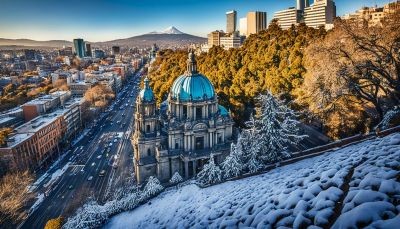Dreaming of a beach escape but worried about the heat? Isla Mujeres, Mexico offers the perfect combo of sun, sand, and peace. Wondering when to visit for the best weather? We'll explore the island's seasonal beauty.
Key Takeaways
- Discover the benefits of visiting Isla Mujeres during the summer, when temperatures are mild, and prices are more affordable.
- Understand the distinct dry and rainy seasons, and how they can impact your travel plans.
- Learn about the hurricane season and how to prepare for potential storm activity.
- Explore the ideal months for beach vacations, from the winter high season to the shoulder seasons.
- Embrace the low season and uncover the hidden gems of Isla Mujeres during the rainy months.
Understanding Isla Mujeres' Weather Patterns
Located on the tropical Isla Mujeres, Mexico has a varied climate. It has distinct weather patterns and seasons. These can greatly affect your trip. Knowing this can help you plan a smart visit to this island paradise.Tropical Climate and Seasons
Northern parts of Mexico are very hot in summer. However, Isla Mujeres itself sees more comfortable temperatures, around mid-80s to 90s. The summer rainy season elsewhere in Mexico turns places lush and green.Cancun, near Isla Mujeres, has a tropical climate. It includes a rainy season from May to October. The Riviera Maya area also experiences a tropical climate with clear dry and rainy seasons.
Dry Season vs. Rainy Season
The dry season in parts of Mexico lasts from December to April. The rainy season goes from May to October. During the rainy season, the weather is green and humid, with rain showers. However, the rain isn't constant throughout the day.Cancun's rainy season aligns with Mexico's general pattern, lasting from May to October. The drier time is from December to April. Beaches in the dry season are great, with less humidity and no seaweed.
Hurricane Season Considerations
Hurricane season in Mexico starts in June, peaking from August to November. Travelers should check if their hotel has a hurricane policy. It's wise to know some hurricane season travel tips. Cancun shares this hurricane season, making it a factor for travelers to Isla Mujeres in summer and fall.Ideal Months for Beach Vacations
Planning a beach vacation in Isla Mujeres, Mexico, timing is key. The perfect time to visit Isla Mujeres is from December to April. During this time, the weather is sunny and warm, with temperatures reaching the 80s.Winter Months: December to April
Cancun, near Isla Mujeres, is bustling with tourists during the winter. The place is crowded, and prices are high. But, the weather in places like the Riviera Maya stays sunny and dry. This makes it a top choice for beach trips in the winter.Shoulder Months: May and November
The winter isn't the only great time to visit Isla Mujeres. According to one source, May and November are also ideal. These shoulder months offer pleasant weather. Plus, there are fewer visitors and better deals than in peak winter.Another source points out that April, May, and November are perfect for Cancun. The weather is nice, and you won't battle the large crowds. Similarly, the third source mentions how these shoulder months allow you to enjoy the Riviera Maya, including Isla Mujeres, without the winter rush.
Summer Travel: Embracing the Rainy Season
Choosing to travel to Mexico during the summer travel season, or the rainy season, has its perks. Smart travelers find great deals and avoid the usual crowds. They get to dive into Mexico's rich culture during special events and festivals.From June to October in Cancun, close to Isla Mujeres, prices drop significantly. Crowds thin out even though it gets rainier and more humid. It’s a perfect time for those watching their wallet to explore Mexico.
Preparing for Rainy Days
If you're heading to Mexico during its rainy season, it’s wise to pack smart. Bring an umbrella or raincoat, light clothes for warmth, and a sweater for cooler nights. Always use sunscreen, even when it's cloudy, to avoid burns. In Cancun, rain showers are brief, quickly making way for sunshine. So, having a plan B for outdoor activities is a good idea.In the Riviera Maya, including Isla Mujeres, how to prep for rainy days isn’t detailed by the third source. However, insights from other sources show that being ready for any weather and flexible with plans is key during the summer.
Spring Break Frenzy
The sunny beaches of Isla Mujeres are alluring, especially in March. It's a key time for spring breakers heading to Cancun, according to the second source. They bring a lively, party vibe to the resorts and beaches.If you're not up for a big party scene, Isla Mujeres might not be the best spot during spring break. The crowds and parties can be a lot to handle. Remember, the second source warns, it might not be very relaxing with all the people around.
The first and third sources don't directly talk about spring break in Isla Mujeres. Yet, the info from the second source hints that spring break time, especially in March, brings in a lot of energy and people. If that's not your thing, it might be smart to look at other travel options for a quieter escape.
Isla Mujeres, Mexico: Best Months for a Weather-Savvy Trip
When you plan a trip to Isla Mujeres, Mexico, timing is everything. Knowing the best travel months and weather conditions is key to a great, weather-smart journey. This will ensure you have an amazing time.Our first source talks about the benefits of visiting in the summer in Mexico. You'll find lower prices and fewer crowds. Plus, you get to enjoy the country's lively cultural events and festivals.
In some parts of Mexico, like the north and the coast, it can get hot. However, the rainy season turns central and southern Mexico into lush green landscapes. This makes your adventures even more beautiful.
The next source looks at travel seasons in Cancun, near Isla Mujeres. It says the low season, from June to October, is great for saving money. You'll find better prices and less people. Although, there might be more rain and humidity then.
Our third source adds more info on Isla Mujeres and its surroundings. It highlights the benefits of going there in the shoulder seasons. During these times, the weather is good, there are fewer tourists, and prices are lower than in the busy winter season.
Combining these sources shows the great things about choosing Isla Mujeres, Mexico for your trip. Whether you want to experience the lively culture, save during off-peak times, or enjoy the beautiful weather, the best months to visit will give you a fantastic, weather-aware experience.
Whale Shark and Sea Turtle Watching
Isla Mujeres, in the Riviera Maya area, is a top spot to see whale sharks and sea turtles. The summer months are the best time to catch these amazing animals. A memorable wildlife watching experience awaits visitors.Whale Shark Season
Between July and November, Isla Mujeres welcomes whale sharks in its waters. You might find these huge fish just off the coast of Isla Holbox or Cancun. It's a unique chance to get in the water with them.Sea Turtle Nesting and Hatching
From May to October, the sea turtle life cycle is on full display in Isla Mujeres. Sea turtles lay eggs on the beach, and baby turtles hatch and head to the sea. You can help at turtle rescue sites or watch them at the beach.Cultural Events and Festivals
Dive into Isla Mujeres' rich culture during summer. This is when Mexico shines with festivals like the famous Guelaguetza in Oaxaca. Don't miss the Isla Mujeres Whale Shark Festival in July. It's a great chance to see these massive gentle sea creatures up close and even swim with them.Isla Mujeres Whale Shark Festival
The Isla Mujeres Whale Shark Festival marks the whale sharks' visit every July. It's perfect for nature lovers and thrill-seekers. You can watch the whale sharks feed on plankton. Then, jump in to snorkel or dive with them, creating a lasting memory.Local Celebrations and Traditions
The summer not only brings big cultural events but also local traditions. Experience Carnaval in February or El Día de los Reyes (Three Kings Day) in January. These events highlight the island’s unique culture with music, dancing, and shared moments. It’s a chance to really understand Isla Mujeres' community and culture.Avoiding Crowds and Peak Season Prices
If you want to save money and avoid crowds in Isla Mujeres, visit during the shoulder season. This period runs from April to May and from November to early December. You'll find the weather nice, the crowds thinner, and prices lower than in winter.Shoulder Season Deals
The shoulder seasons offer great deals for people wanting to skip the busy times. In Isla Mujeres, coming during April to early December means less people and lower costs. But, you still get to enjoy sunny days and all the island has to offer.Low Season Discounts
For those watching their wallet, the low season from June to October is perfect. Prices drop a lot, and it's not as crowded. Yes, it might rain more and be a bit humid. Yet, it can be a very low-cost way to enjoy Isla Mujeres and Cancun.Beach Conditions and Sargassum Seaweed
When you visit Isla Mujeres in the summer months, you should know about sargassum seaweed. It can cover the beaches. This problem is worse in the rainy season. At times, beaches become unswimmable. The issue also affects places like Cancun.Isla Mujeres is part of the Riviera Maya region. Here, the third source talks about beach conditions. Many resorts clean their beaches and deal with the seaweed. They also use sand barriers to stop erosion. But, these barriers might not look good.
Knowing about the seaweed before you go to Isla Mujeres is smart. It helps you plan your beach time. You can choose the best times and places to enjoy the island's beautiful shores.
Planning Your Isla Mujeres Adventure
Getting ready for your Isla Mujeres trip? There's a lot of accommodations to fit anyone’s budget and liking. You can check the third source for info on different resorts in the Riviera Maya, which includes Isla Mujeres.Best Accommodations for Different Budgets
Looking for a fancy beachside place or a cheaper stay with everything included? Isla Mujeres has it all. From Atelier Playa Mujeres to Banyan Tree Mayakoba, each place offers something unique for all kinds of traveler budgets and preferences. Spend some time looking through these options to find what suits your Isla Mujeres trip best.Essential Packing Tips
Getting ready for Isla Mujeres means preparing for the warm, tropical weather. The first source has some good tips. They suggest packing an umbrella, light clothes, and a cozy jacket for cooler nights. You should also bring a lot of sunscreen since you can still get sunburnt even when it's cloudy.Conclusion
Your journey to Isla Mujeres, Mexico is now within reach, thanks to the insights gleaned from this comprehensive guide. Whether you're seeking the perfect weather conditions, the best opportunities for wildlife watching, or the chance to immerse yourself in the region's vibrant cultural events, the key is to time your Isla Mujeres adventure strategically.When planning, keep the weather in mind. Think about hurricane season, the rainy season, and sargassum seaweed along the coast. This way, you will have a smooth and fun island visit. Try visiting during the quiet times to miss the big crowds and save money. This will help make the most of your vacation budget.
By knowing about Isla Mujeres' unique weather and seasons, you can get ready for your Mexico trip. Enjoy your time on the island with great memories of its natural beauty and rich culture. Be flexible and ready to change plans with the weather. And let the stunning island of Isla Mujeres amaze you at every turn.
FAQ
What are the best months to visit Isla Mujeres, Mexico?
The top times to go to Isla Mujeres are in April, May, and November. The winter from December to April is good too. You'll find nice weather, fewer people, and better prices.
What is the weather like in Isla Mujeres throughout the year?
Isla Mujeres is usually sunny and warm, with a rainy season from May to October. The best weather is from December to April. During the rainy season, there might be seaweed and more humidity.
When is hurricane season in Isla Mujeres?
Hurricane season starts in June and is strongest in August to November. Be sure your hotel has a hurricane plan. Also, prepare for bad weather during these months.
What are the benefits of visiting Isla Mujeres during the summer months?
In summer, prices are lower, there are fewer people, and you can enjoy cultural festivals. But, it is the rainy season. So, expect more rain and humidity.>
When is the best time to see whale sharks and sea turtles in Isla Mujeres?
Whale sharks are best seen from July to November, and sea turtles' nesting runs from May to October. You can swim with sharks or watch turtles on the beach.
What cultural events and festivals take place in Isla Mujeres?
The Isla Mujeres Whale Shark Festival is in July. This is when you can get close to whale sharks. Summer also brings Mexico's colorful festivals like Guelaguetza in Oaxaca and a Folkloric festival in Zacatecas.
What are some of the best accommodations options in Isla Mujeres?
The third source looks at resorts and hotels in the Riviera Maya area, which includes Isla Mujeres. It features places like Atelier Playa Mujeres and Banyan Tree Mayakoba. There's something for everyone's budget and preferences.



